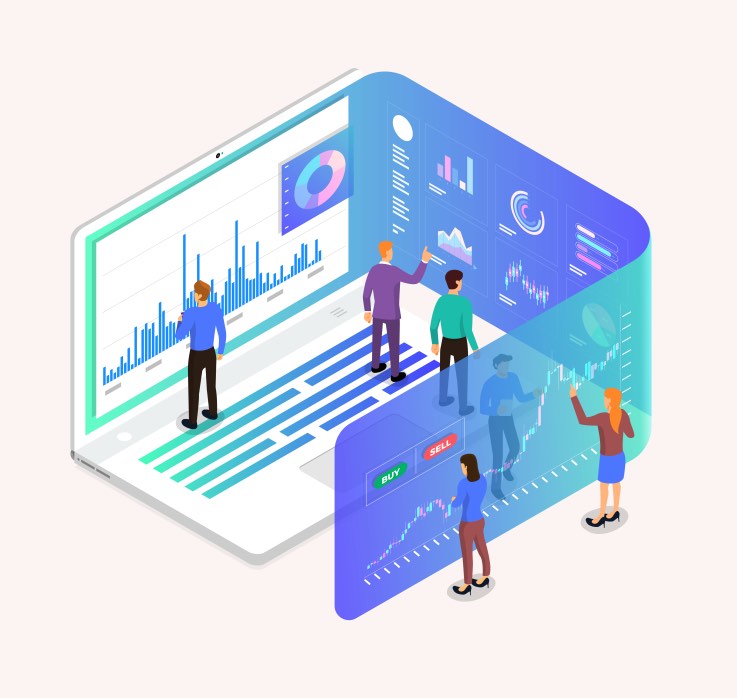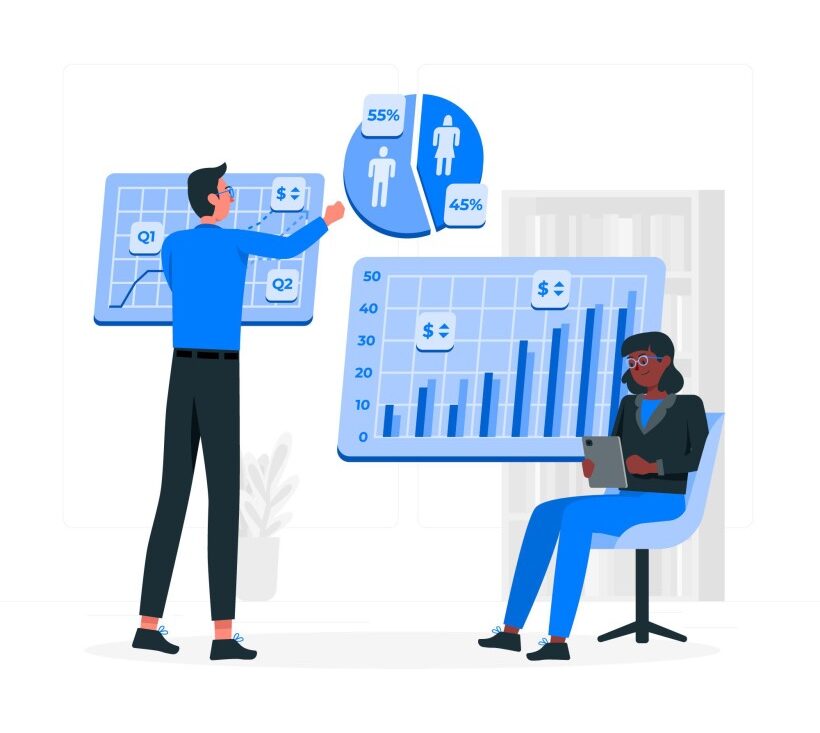The amount of data available has never been higher in number than it is now, nor has access to it ever been easier for marketers and businesses. We even have data about data, analytics, and accuracy of said data!
To be uninformed is to simply not try hard enough. But how do you make human-focused, data-driven decisions in your company? You have the raw materials but without humanizing the data to get honest truth, that alone is worthless.
Here’s how to filter the endless streams of data and leverage it into reports you can use.
A Breakdown of Data, Analytics, and Insights
The collected information is the data that informs the analytics of what you have, which is compiled into reports for you to understand the data. Insights are the concepts you face that inform what the data implies about your company.
Data
Data is information that has not been processed, categorized, or analyzed. It’s a raw dump of facts and figures that can be aggregated into more enlightening findings. Raw data has no pattern or rhythm. It is simply the facts.
Analytics
Analytics will divide the information into smaller batches by any desired category or context. This is an organized overview of what data you have based on the key indicators you choose.
Insights
Insights are what you gain from analyzing the data. This is the “why” of the information presented.
By providing context to the analytics, you can draw conclusions based on your discoveries. Only then can you finally begin implementing an action plan.
Principles of Gaining Insights from Data
Data and reports aren’t enough to drive clear action. It’s critical for decision-makers to understand the information and what the implications are. What is the connection between the data and the action?
Comprehending the facts and statistics is what bridges the gap from data to decision. When there is an abundance of data or complex data, which is often the case, the bridge is even more critical.
There is a practical three-step method of collecting the essential insights from available data, and it starts with collaboration.
Essentials of Collaboration
No matter the size of your company, the more hands in the pie, the less one slice will naturally talk to another. This creates information silos and communication barriers that make it difficult to bring everyone together on a single concept.
In order to get a complete understanding of data and how it connects to the end goal, there must be clear channels of open communication. When everyone is on the same team, working towards a common goal, all the data you need should be easily collected and understood.
Teamwork and Transparency
When you have a multitude of data handlers within your company, they will each have their take on the data and what needs to be shared. All teams and departments must communicate openly and completely about relevant data.
It’s important that your analysts get their hands on as much raw data as possible, as they will know how it should be compiled. This allows the decision-makers to stay focused on their goals and on what insights will inspire necessary action. Transparency in your teams will propel more transformative insights.
Do you want to gain a real competitive advantage by humanizing your data?
Contact Growth Hackers
Goal-Oriented Processes
From the lead generation process, data collectors and aggregators to management and decision-makers, every player in the game should be able to define specific expectations, requirements, project intent, and desired goals.
This specificity is what you need to ensure the right questions are being asked and the correct reports are being compiled so that the most useful insights can be extracted. The journey starts with the end in mind.
Applying Data Insight Concepts
While there is no cookie-cutter approach to extracting insights for your business, there are proven processes in existence that relieve you of the pressure to reinvent the wheel.
Define The Right Questions
If you expect them to adhere to specific requirements, you must ask specific questions to get at the correct insights. A generic approach to this could lead to a whole rabbit trail of hypotheticals and theories.
Instead, ask targeted questions you want answers to. Instead of asking “how can we increase revenue,” which will yield a whole host of different answers, ask “what marketing channel cost the least in ROAS that yielded the most leads?”
That looks like this: “What did we do that got us what we do want, without the thing we don’t want?” This formulaic approach to your process will keep your goals front and center.
Clarify Operational Context
How do you know what metrics to monitor? By clearly understanding the context of the data and analytics. What are the motivations or restrictions? What are the desired results?
Every piece needs to connect with the end goal to make sense of the data. That’s where statistical thinking for data science and analytics can help.
Set Clear Expectations
The data collected can serve multiple insights and help you answer more than one question. Again, here we speak of knowing the end of the journey before you start. The insights you need should inform the analytics you have from the data on hand. Your process will be informed by the results you need.
SMART KPIs
Unrealistic or unmeasurable goals never helped any business, ever. Always highlight the well-known and highly effective way of determining your metrics and KPIs. Your goals must be SMART!
- Specific
- Measurable
- Attainable
- Relevant
- Time-Bound
Of course, data isn’t always comprised of numbers and hard data. When you include the human factor, it could be observations, energy, experience, and opinion. From soft data like this, you can still derive your measurable KPIs.
Develop Your Theories
Different from factual data, a theory or hypothesis is the projected and strategic guesswork or supposition based on a limited scope of startline information.
For example, the idea that you need to change the creative elements you’ve matched with your ad copy to reduce confusion and increase leads is a supposition. If putting that theory to work doesn’t change your results in the way you predicted, you develop a new theory and move on to other elements that may need improvement in order to boost conversions.
Collecting Data That Matters
Before you start asking questions about the collected data, ensure you’re looking at the data that’s relevant. Does this information influence the desired outcome? Does it provide an alternate perspective on existing data?
Multiple layers of testing may be required before you begin to get what leads to the answers you’re looking for.
Segment Data As Much As Possible
To get a more granular view of the data, leverage smaller segments. Dive deeper into what’s there rather than trying to extract one needle from a haystack.
Categorizing the information based on audience, industry, demographics, or any other relevant metric will give a more accurate and comprehensive view of the data overall.
Start humanizing your data and stay ahead of the competition now!
Correlate and Incorporate
When you collect data from multiple sources, you guarantee the ability to grasp a more comprehensive view of the data at hand. Always choose the highest quality data available to support the questions you seek answers to.
Incorporate the data from all available sources and correlate it together. Don’t forget to incorporate vital statistics such as customer attrition and bounce rate where relevant.
Benchmarking Data
Congratulations! You have data, and it’s starting to tell you a story. This is where a lot of startup founders, entrepreneurs, business owners and digital marketers often fall short. You don’t just want to collect data, you want to understand it and most importantly act on it. Execution of your learnings is one of the best growth hacks you can leverage.
But how can you tell where it is in comparison to the big picture? What is the context of this data?
It’s time to see where you stand up against any relevant benchmarks. Measure your data against last year’s data, the data from your last campaign, your competitors, or industry-standard numbers in order to identify your progress and what it means.
This will help you distinguish trends, user behavior, anomalies, and potential growth rates so you can definitively pinpoint where you land in the competitive landscape.
Recognize Trends
Like the fractals of science, every data metric you can measure will reveal a pattern. The insight lies in understanding the relevance of each one. This will help you illustrate industry changes, behavioral anomalies, and even seasonal spikes or declines.
For example, during the holidays we noticed that our content creation studio page would experience a spike in online traffic right before the holiday season. Our team immediately began strategizing on how to capitalize on this type of increased traffic.
This data will arm you and your team with effective ways to enhance your efforts when and where needed.
Systematize Your Process and Repeat
Data doesn’t work like a crock pot. It’s not a fix-it-and-forget-it kind of entity. It’s fluid and as organic as the humans who give it to us.
It’s critical to be consistent in gathering and analyzing data for the long-term success of your business. What is true today will not necessarily be true next month or even tomorrow.
Draft a rinse and repeat process for achieving your goals and insights and save yourself time and money.
Closing Thoughts About Humanizing Your Data Analytics
Humans can’t be measured. They can be predicted and catered to, but a human person’s intent, desires, and dreams cannot be fully quantified by any business or marketer out there.
We can only follow the data they give us and let that paint the picture for us. If you let the information and context lead your insights, you will always end closer to your goals.
Growth Hackers is an experienced data analytics agency helping businesses from all over the world grow. There is no fluff with Growth Hackers. We help entrepreneurs and business owners humanize their data to gain a competitive edge, increase their productivity, generate qualified leads, optimize their conversion rate, gather and analyze data analytics, acquire and retain users and increase sales. We go further than brand awareness and exposure. We make sure that the strategies we implement move the needle so your business grow, strive and succeed. If you too want your business to reach new heights, contact Growth Hackers today so we can discuss about your brand and create a custom growth plan for you. You’re just one click away to skyrocket your business.









